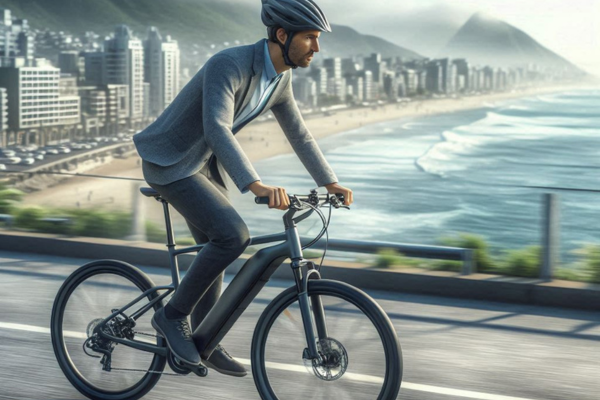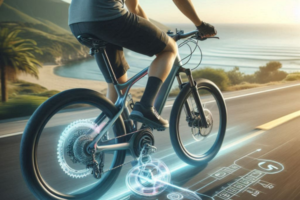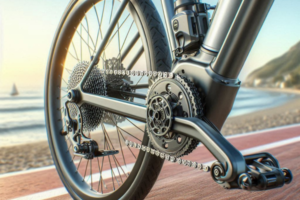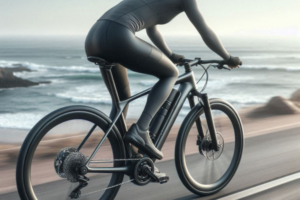🧠 Mental Focus: The Hidden Engine Behind Speed
When it comes to enhancing speed on an electric bicycle, most riders concentrate on physical aspects like motor power, battery efficiency, or tire pressure. However, an often-overlooked element plays a crucial role in performance: the mind. Mental focus, confidence, and decision-making directly influence how fast—and how safely—you ride. Understanding the psychology of speed can transform you into a more efficient, aware, and confident rider, especially in challenging coastal environments.
🌬️ The Coastal Challenge
Coastal areas present unique challenges for e-bike riders. Sudden gusts of wind, slippery roads due to moisture, and visual distractions from the scenic environment can all impact your riding performance. In such settings, mental focus becomes paramount. A distracted mind can lead to slower reaction times and inefficient riding paths. Conversely, a focused mind allows for smarter route choices, better posture maintenance, and anticipation of road conditions—all contributing to increased speed and safety.
🎯 The Power of Intentional Riding
Before embarking on a ride, take a moment to set clear intentions. Whether it’s maintaining a higher average speed or navigating corners more smoothly, having specific goals creates mental clarity and motivation. This practice encourages consistency, a key factor in long-term performance improvement.
📵 Minimizing Digital Distractions
While smartphones and music apps are common companions during rides, excessive use can fragment your focus. Limiting screen time or using apps that provide real-time feedback without diverting your attention can help maintain mental clarity. Staying present in the moment enhances your ability to respond to environmental changes swiftly.
💨 Breath Control for Calmness
Deep and rhythmic breathing helps calm the nervous system. A relaxed body leads to a clearer mind, enabling faster and more confident decision-making, especially during sudden terrain changes or when facing wind resistance. Incorporating breathing exercises into your riding routine can significantly enhance mental focus.
🧘 Visualization: A Tool for Speed
Elite athletes across various sports utilize visualization to enhance performance. This technique involves mentally rehearsing specific scenarios before they occur. For e-bike riders, visualization can include:
- Maintaining an aerodynamic posture on long straights
- Approaching turns smoothly and efficiently
- Responding confidently to crosswinds
Visualization builds neural pathways that enhance muscle memory, helping your body react faster and with greater control. Over time, this mental training supports both higher speeds and safer riding practices.
🛣️ Confidence and Control in Coastal Conditions
Coastal cities often bring unpredictable elements: sudden gusts of wind, moist roads, and increased pedestrian traffic. These variables can trigger hesitation, which slows you down. Developing mental resilience helps you stay in control.
🔁 Build Confidence Through Familiar Routes
Riding familiar coastal paths repeatedly allows you to develop route-specific strategies: when to accelerate, when to coast, and where to adjust for wind resistance. The more familiar the route, the more mental energy you save—and the faster you can ride.
🔄 Recover Quickly from Mistakes
Even experienced riders make errors. What matters is how quickly you recover. Cultivating a growth mindset—one that sees mistakes as learning opportunities—will improve your performance under pressure and keep your momentum high.
🧭 Mind Over Metrics: Trusting Intuition
Data from apps, power meters, and speedometers can be useful, but they shouldn’t override your internal cues. Sometimes, your body knows better than the screen. If you feel like you’re pushing too hard despite “good numbers,” it may be time to ease off and refocus. Likewise, if you feel mentally sharp and physically strong, but your speed is slightly lower than expected, trust the process. Coastal riding is full of invisible variables—focus on consistency, not perfection.
📝 Long-Term Mental Strategies for Speed Optimization
To stay mentally sharp over time, consider adding these habits to your regular routine:
- Daily movement: Light stretching or mobility helps release physical and mental tension.
- Journaling your rides: Reflecting on what worked and what didn’t builds self-awareness.
- Riding with intention, not ego: Focus on your own goals instead of competing with others.
When you take care of your mind, your body follows. Mental focus is the hidden engine behind speed, especially in the ever-changing conditions of coastal environments.
🎯 Mental Techniques to Improve Speed and Performance on Your E-Bike
Mental strength isn’t just for competitive athletes—it’s a tool every electric bicycle rider can harness. Whether you’re commuting, cruising coastal paths, or building endurance, your mind plays a key role in how fast and efficiently you move. Let’s explore how mental focus, clarity, and preparation can increase speed and control without touching the throttle.
🧠 Mental Training Equals Physical Output
Studies in performance psychology consistently show that mental focus boosts physical outcomes. This applies to e-bike riding too. The sharper your focus, the more smoothly you shift gears, the more consistently you maintain posture, and the quicker you adapt to changes in terrain. A well-trained mind anticipates, rather than reacts—and this anticipation saves seconds and energy.
🧘 Visualization Routines for E-Bike Riders
Visualization is a technique used by professional cyclists to mentally prepare for rides before they happen. The goal is to “rehearse” the route, challenges, and desired outcomes in your mind. Here’s how to adapt it to your electric bicycle routine:
- 🏁 Before the ride: Picture your route, including turns, hills, intersections, and areas of known wind resistance.
- 🎯 Set an outcome: Visualize maintaining a consistent speed, staying relaxed, and handling transitions smoothly.
- 🌊 Include variables: Imagine overcoming a gust of wind, avoiding obstacles, or reacting calmly to rain-slick roads.
📈 Table: Mental Technique vs. Speed Outcome
| Technique | Immediate Benefit | Long-Term Speed Impact |
|---|---|---|
| Visualization before riding | More confidence and direction | Improved riding rhythm and efficiency |
| Breathing awareness | Lower anxiety and smoother pedaling | Better endurance and mental clarity |
| Positive self-talk | Less hesitation on wet or complex paths | More consistent speed and flow |
🧏 Managing Distractions and Riding in the Now
Your surroundings in coastal or urban areas can be mentally noisy—cars honking, people crossing, unpredictable winds. Learning to bring your attention back to the present moment is key. Try these mindfulness cues:
- 🌀 Focus on your breath: Inhale deeply, exhale slowly—match your breathing to your cadence.
- 👀 Notice your visual field: Stay alert to road textures, reflections, and wind-blown debris.
- 👂 Listen to your tires: The hum or hiss of contact with the road tells you more than any screen.
🛞 Emotional Regulation in High-Speed Situations
Speed triggers adrenaline—and while that can feel thrilling, it can also lead to overcorrection or panic in slippery conditions. Training your emotional response helps avoid performance crashes. When your heart rate spikes, shift your attention to one grounded cue: your breath, your handlebars, or your foot position. This micro-reset helps stabilize your ride without losing momentum.
💡 Visual Analogy: Mental Focus Is Your Internal GPS
Imagine riding without any map or screen. Your intuition, powered by mental focus, becomes your internal GPS. When trained, it tells you when to push, when to hold back, and when to adjust for weather or terrain—quicker than any app ever could.
💡 Pro Tip: Add 3–5 minutes of visualization and deep breathing before every ride. You’ll arrive calmer and ride sharper, especially in unpredictable coastal conditions.
💡 Reflection: A focused rider sees challenges as chances to flow—speed is not always about more effort, but better attention.
⚠️ Common Mental Mistakes That Kill Speed on Your E-Bike
Mental focus is one of the most valuable performance tools for e-bike riders, especially in humid or coastal environments. But just as good habits enhance speed, mental errors can slow you down—sometimes without you even realizing it. Recognizing and correcting these mistakes is the first step to unlocking smoother, more efficient rides.
🛑 Mental Pitfalls That Sabotage Performance
- Overanalyzing data mid-ride: Constantly checking speed, cadence, or power output pulls your attention away from the road and disrupts flow.
- Negative self-talk: Phrases like “I’m too slow” or “I’ll never get past this hill” directly affect your muscle response and confidence.
- Tunnel vision: Focusing too much on the bike in front of you, a single route, or one metric can cause you to ignore better opportunities to adjust posture, path, or pace.
- Unrealistic goal setting: Pushing to beat a personal record every single ride creates mental burnout, fatigue, and frustration.
- Fear of weather or conditions: Anticipating failure in wind or wetness leads to stiff riding posture and slower decision-making.
📊 Table: Mental Error vs. Impact on Speed
| Mental Mistake | Effect on Performance | Speed Impact |
|---|---|---|
| Overchecking data | Loss of present-moment awareness | Inconsistent pacing |
| Negative inner dialogue | Decreased confidence and fluidity | Reduced responsiveness |
| Goal obsession | Stress and tension in riding posture | Lower efficiency and enjoyment |
📋 Corrective Mindset Shifts
Replacing harmful thought loops with constructive mental frameworks will not only increase your speed—it will also make your rides more fulfilling.
- ✅ Replace “I’m behind” with “I’m consistent.” Consistency trumps comparison.
- ✅ Switch “I’m not fast enough” to “I’m learning what works.” Growth happens with patience.
- ✅ Move from “This route is hard” to “This route teaches me control.” Every ride is information.
🔁 Break the Loop with Breathing and Reset
If you catch yourself falling into any of these patterns mid-ride, perform a 30-second reset:
- 🧘♂️ Take 4 deep, steady breaths—inhale through the nose, exhale through the mouth.
- 👁️ Gently shift your focus from the screen or road data to the environment—notice colors, shadows, and road texture.
- 🦶 Wiggle your toes or shift your foot placement—this draws awareness back to the present and activates grounded control.
💡 Visual Analogy: Mental Blocks Are Like Fog on Your Visor
Imagine riding with a fogged-up helmet visor. You can still pedal, but your vision is limited. Mental mistakes work the same way—they blur your performance, restrict clarity, and slow your reaction time. But just as you’d wipe the visor clean, you can clear mental fog with intentional awareness and reset.
💡 Pro Tip: Choose one positive phrase (like “smooth and steady”) and repeat it silently during difficult sections. You’ll be amazed how your posture, speed, and energy respond.
💡 Reflection: The road doesn’t need to change—your mindset does. And when it does, speed follows.
🧘 Weekly Mental Focus Routine to Boost E-Bike Speed
Building mental strength isn’t something that happens overnight—it requires regular training, just like physical conditioning. A structured weekly routine focused on mental clarity and emotional regulation can significantly enhance your performance on an electric bicycle, especially in humid or variable coastal environments where the mind is constantly tested by distractions, weather, and unpredictable terrain.
📆 Weekly Mental Focus Planner for Riders
Set aside small, intentional time blocks during your week to train your mind just like your legs. Here’s an example schedule for maintaining strong mental performance without overwhelming your daily life:
| Day | Focus Exercise | Purpose |
|---|---|---|
| Monday | Visualization for the week’s key ride | Establish intention and improve confidence |
| Wednesday | Breath control & posture awareness session | Reinforce body-mind connection under tension |
| Friday | Positive self-talk journaling (10 minutes) | Reframe self-perception and enhance mental clarity |
| Weekend (Sat/Sun) | Mindful riding on familiar route (no screens) | Sharpen presence and test focus in action |
📋 Weekly Rider’s Checklist
Keep this checklist posted near your bike or gear station. It’s a simple tool that reminds you that mental focus is a skill worth practicing—week after week:
- ☐ Did I mentally visualize my route before riding?
- ☐ Did I reset my posture and breath mid-ride?
- ☐ Did I respond to setbacks with curiosity, not judgment?
- ☐ Did I ride with presence—not distracted or rushed?
- ☐ Did I end my ride with a reflection or takeaway?
💪 Long-Term Mindset Conditioning Tips
To maintain consistent speed and resilience, consider integrating these mindset-strengthening practices throughout the year:
- 📖 Read books on flow, focus, or endurance: Expand your mental toolkit beyond the handlebars.
- 🧠 Learn about neuroplasticity: The brain adapts as fast as your legs—train it to support high-speed thinking.
- 🎯 Celebrate small wins: Don’t wait for massive milestones. Every ride completed with focus is a success.
🧠 Visual Analogy: The Brain Is Like a Gearbox
Just like your e-bike has gears that shift for different terrain, your mind has mental “gears” that allow you to adjust based on environment, energy, and confidence. But to access those gears smoothly, you need to maintain the system. This weekly routine is like lubricating the mental gearbox—preventing burnout, hesitation, and gear-grinding frustration.
💡 Pro Tip: Pair mental training with recovery. A 10-minute meditation after a long ride improves both physical repair and cognitive resilience.
💡 Reflection: It’s not just the ride that shapes you—it’s how you prepare for it. Every thought you train becomes part of your momentum.
💬 Frequently Asked Questions (FAQs) on Mental Focus and Cycling Speed
Does mental focus really affect my riding speed on an e-bike?
Yes—mental clarity directly impacts reaction time, posture, and decision-making. Focused riders maintain better momentum, adapt quicker to terrain changes, and preserve energy, all of which contribute to sustained higher speeds.
How long does it take to improve mental focus for cycling?
You can start seeing benefits within a week of consistent practice. Even a few minutes per day of visualization, breathing exercises, or mindful riding can sharpen awareness and boost performance noticeably.
What are some signs that I’m mentally fatigued while riding?
Slower reaction times, increased distraction, negative self-talk, and inconsistent speed are key indicators. If you’re zoning out or making small mistakes repeatedly, it’s time to pause and reset.
Can I train mental focus without riding?
Absolutely. Visualization, meditation, breathwork, and even journaling are effective off-bike techniques. They help you build the same cognitive pathways that support focused and efficient riding.
Should I prioritize mental training over physical training?
Think of them as complementary. Physical preparation builds capacity; mental focus unlocks it. The strongest motor means little if your attention is scattered. Combined, they create unstoppable momentum.
💖 Final Thoughts: Train the Mind, Unlock the Ride
Speed is not just about mechanics—it’s about mindset. You can have the best battery, the lightest frame, and the most aerodynamic posture, but without mental clarity, those advantages fade. When your thoughts align with your movement, something powerful happens: you ride with presence, purpose, and peace.
Coastal paths, rainy streets, and unpredictable winds are not obstacles—they’re part of the journey. And your mind, when focused, becomes the most reliable part of your e-bike. It navigates distraction, turns setbacks into adjustments, and creates the conditions for your body to perform at its best.
💡 Inspiration: True speed is silent—it comes not from noise or power, but from precision, clarity, and intention.
🌍 Join the Conversation: How Do You Train Your Focus?
Have you noticed how your mindset affects your riding? Do you have a personal ritual that helps you stay focused and steady, especially in humid or challenging environments?
We’d love to hear your insights:
🧠 What mental practice helps you ride better?
🌊 How do you reset your focus when riding in wind or rain?
📓 Do you keep a journal, use affirmations, or visualize before rides?
Your story might inspire someone else to push through mental fatigue, find clarity on coastal roads, or simply enjoy their ride more. Leave a comment and help grow a community where speed isn’t about showing off—it’s about showing up, focused and free. 🚴♀️💬🌎



